Power Shift - Thermal Imaging
Air Date: Week of November 16, 2012
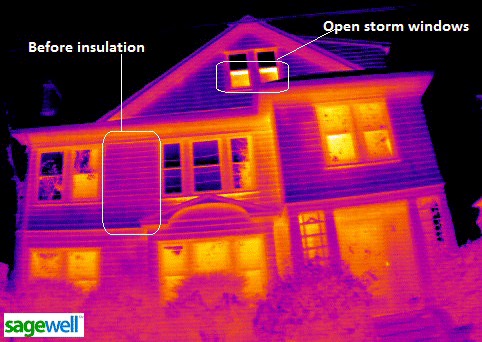
MassSave takes pictures with a thermal camera that let you see with your own eyes where heat is leaking out of walls and windows in your home. It's a powerful spur to persuade you to improve insulation and keep the storm windows closed. Living on Earth’s Helen Palmer reports.
Transcript
CURWOOD: The cheapest energy is the energy never used – and that’s an incentive to seal up houses to get rid of drafts. But you can't see leaks, and the conventional blower tests that are used to find them can be expensive and annoying. Now there’s a revolution in draft detection, and it’s called thermal imaging. A heat-sensing camera can quickly and cheaply snap a thermal picture that reveals heat loss.
Where a house is well insulated the image glows a cool blue, and warm red – or even white – shows up where heat is escaping. Thermal images of homes are now being created in many states – and Massachusetts householders are among the leaders in checking them out and taking action. Living on Earth's Helen Palmer has the story from a street famous for reenacting the start of another revolution more than two hundred years ago.
[HORSE AND STREET SOUNDS]
PALMER: Every April, Paul Revere gallops from Boston out west through Arlington to warn the Minutemen of the approaching army. “The Red-Coats are coming!” he shouts. Well this fine November day – the weatherizers are coming – to Paul Revere Road in Arlington.
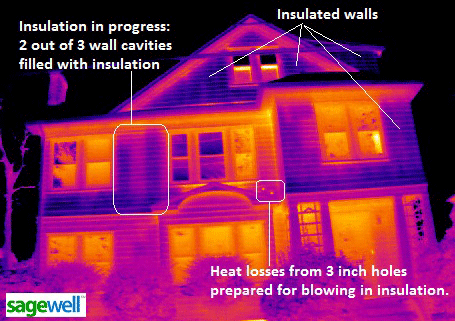
After insulation treatment
DANIELS: My name is Leah Daniels. We do weatherization, insulation services, help people shrink their carbon footprint by insulating their walls thereby saving them money on their heating bills and heating costs.
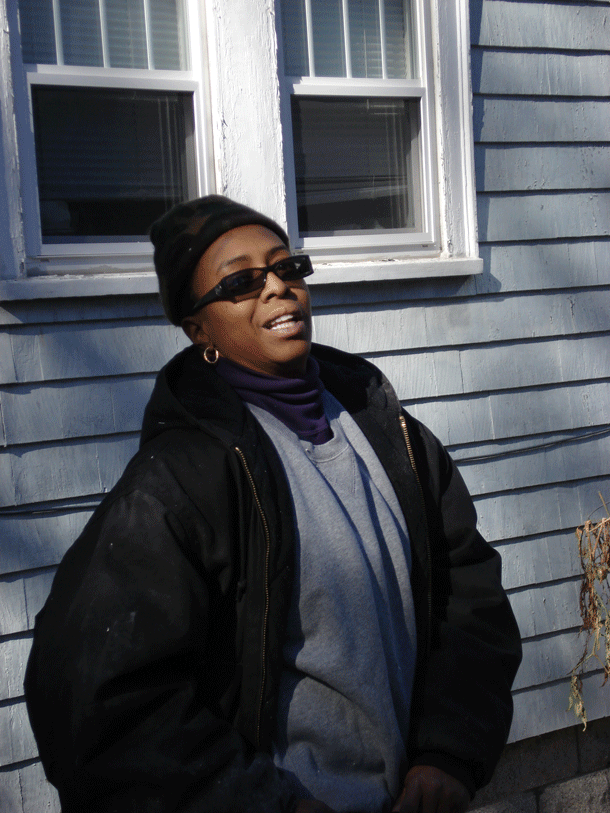
Leah Daniels, CEO of Green Beginnings. (Photo: Helen Palmer)
PALMER: Daniels is a veteran. Her company, Green Beginnings, is one of dozens certified by Mass-Save, an energy-saving program funded by utilities and contractors in the Bay State. Mass-Save offers energy audits, retrofits, rebates and energy saving products and ideas to homeowners and renters. Today, Daniels and her crew are preparing to fill all the spaces in the floors and walls of this big old New England triple decker with insulation.
[KNOCKING, SQUEAKS OF CONSTRUCTION]
PALMER: This means they have to pull up floorboards in the attic…
[DRILLING SOUNDS]
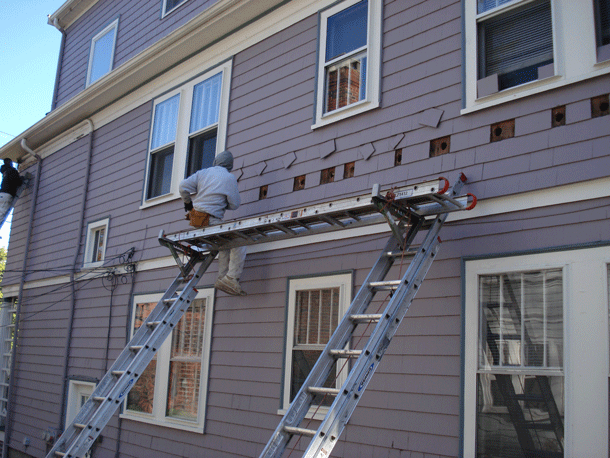
Holes drilled in the house ready for insulation. (Photo: Helen Palmer)
PALMER: …and pry off some shingles to drill holes in the side of the house. So these holes are about 2 inches across…
DANIELS: 2 and 9/16ths to be exact
PALMER: 2 and 9/16ths…and that’s so you can shove in the hose with the insulation?
DANIELS: Correct.
PALMER: The hose is wide and white - it snakes along the ground from a large grey hopper in Daniels’ van and up through a window into the attic, where the crew is already blowing the fluffy gray insulation into the gaps between the joists.
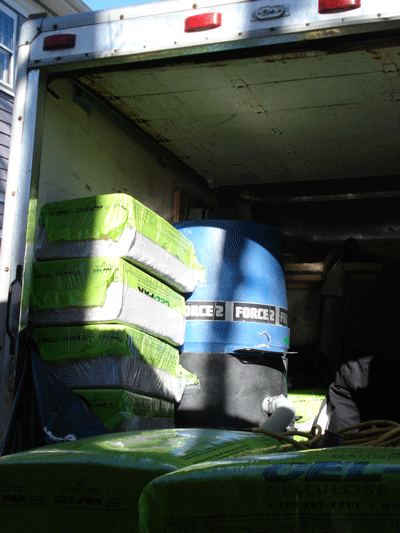
The hopper that forces the insulation into the house; the bales are the cellulose insulating material. (Photo: Helen Palmer)
[HOPPER BLOWING SOUNDS]
DANIELS: It’s just ground up newspapers – all the old newspapers that you don’t read go to this company and they just chop it down to really, really fine and so when it gets into the walls it dense packs itself, so it gives you a thermal barrier from the outside air temp to the inside air temperature.
[BLOWER NOISE, HAMMERING]
PALMER: Part of what persuaded the homeowners to improve their insulation was a thermal image of their house. Pasi Mietinnen is CEO of a company called Sagewell that provides these images.
MIETINNEN: You can think of it as Google Street View – except in measuring heat coming out of the building. So we have anywhere from 4-5 pictures and sometimes more of your house from the street and what it shows is heat escaping from the building through the windows, the doors, the basement, wherever heat comes out.
PALMER: The images of this house showed plenty of room for saving energy, and cash, but that wasn’t the only thing that persuaded the home-owners, Steve Simon and Fran Kuebler to call in the energy-saving team today.
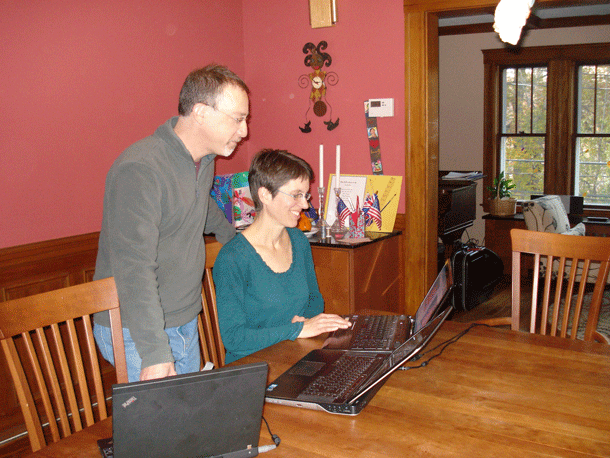
Fran Kuebler and Steve Simon examine the thermal pictures. (Photo: Helen Palmer)
KUEBLER: Well I’m a person who always feels cold – so I would love to have the thermostat nice and high and toasty all the time, but I realize that’s not good for the bills or the environment.
SIMON: Her husband won’t let her do that!
PALMER: So Steven, were the bills part of the incentive to get it done?
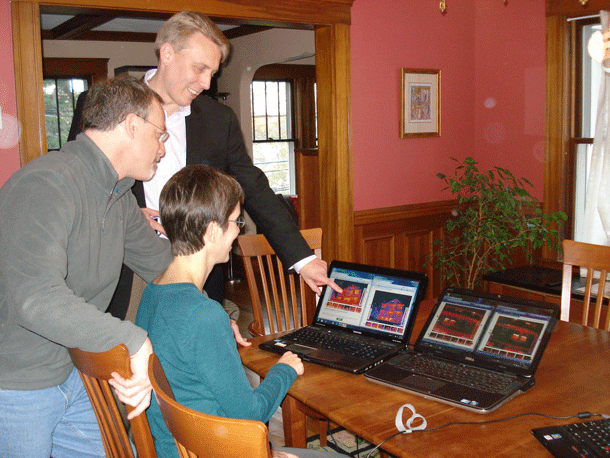
Pasi Miettinen shows Fran and Steve before and after thermal images of their home. (Photo: Helen Palmer)
SIMON: I think the bills, yes; I think looking at the pictures certainly were a factor, and I think when you study the incentives that are available to the homeowner, I think it’s a no-brainer decision, you make the money back pretty quickly.
PALMER: And you have a warm cozy house as well. After the crew finished the insulation, Sagewell took some new thermal views. Mietinnen lined up a couple of computers to show Fran and Steve the post and pre-insulation pictures.
MIETTINEN: The walls on 2nd floor that were not insulated are bright on the top, and as the insulation has been sagging, it gets cooler and cooler on bottom of that wall and you also had a couple… at least one window, storm window that was open there that’s easy to fix.
SIMON: I must say the pictures are a great incentive to keep the storm windows down – they very much work!
MIETTINEN: So, now when you look at post-insulation images what you’ll see is the walls are considerably cooler. Now you see a lot more blue – where you used to see orange, which indicated a higher temperature. So the walls are considerable cooler now.
PALMER: So now you’ve seen the, as it were, the before and after – what’s your reaction?
SIMON: I’m impressed – I think it’s a very powerful tool to give you the incentive to do it to begin with, clearly you can see the results. It’s fabulous.
PALMER: That reaction would please Sue Kaplan. She’s the acting director of energy efficiency at Massachusetts’ Department of Energy Resources – and something of a fan of thermal imaging.
KAPLAN: The different colors will point your eye right to where your dollars are more or less flying out of your building. And, you know, it’s one of the things we're testing to see whether it’s as powerful a motivator as we think it may be. The Department of Energy Resources has a grant from the Department of Energy and the federal government to test how well thermal imaging contributes to people’s interest in investing in their homes so that their bills can potentially decrease.
PALMER: Kaplan says the results aren’t in yet, but Pasi Miettinen says his company has seen a lot of interest in the images. They now have pictures of over 400,000 houses in Massachusetts, and each night add another 10-20,000 buildings to that total – the images are available free to householder's on Sagewell’s website.
He expects to have thermal pictures of most of the colder states in the country in a couple of years. As for Massachusetts, he says 15% of people getting energy audits now do so after visiting his website and seeing where they’re losing heat. I wanted to see for myself - so he brought his imaging van round to my house, and we went for a drive with the company’s energy efficiency analyst Jennifer Mussoff.

Sagewell Imaging Vehicle
[VAN SOUNDS]
MUSSOFF: It’s a lot different to look at a thermal image than it is to look at a picture you might take with your camera or your smart phone.
PALMER: Yes, it’s so different - you’ve got the blue houses and the black sky!
MUSSOFF: Mmhmm. Each temp reading is given a color representation.
PALMER: And can you capture these as you drive by at 30 mph?
MUSSOFF: Absolutely, we’re capturing right now. You know, it’s New England – a lot of people have trees and shrubs in their front yard, for example this house on the right has lots of bushes. You can't see though fences, can’t see through trees, absolutely can’t see through windows.
PALMER: But she did have an image of my house – and showed it to me:
MUSSOFF: You can see that there is quite a bit of insulation, you can see the studs and the pattern of the beams that surround the insulation itself - but overall I'd have to say the front view of your house shows so much insulation is there that you're doing quite well.
PALMER: Which is a relief – as we paid to get the work done – and it has paid off in lower heating bills. Indeed, Massachusetts efficiency chief Sue Kaplan says each dollar invested in insulation and other improvements returns $4 to the householder, and the push to save energy in the state is getting results.
KAPLAN: We have been ranked both last year and this year as the most energy efficient state in the country - and that’s not only in the policies - but the level of investment and the level of savings.
PALMER: Still, people often need a push to decide to actually get the job done – and the pictures – with the bright oranges and reds and whites showing where you’re heating the atmosphere outside your home -- can have that effect for many folks. Pasi Mietinnen has an apt analogy.
MIETINNEN: What we tend to say is that if you had a water leak in your basement, of course you would call a plumber – but if you have a heat leak in your building, you don't see it until you look at it in a thermal image. And a lot of people, when they see the imagery of their house, they have one of these moments where they go: ‘Wow I really need to do something about this right now,’ and that’s how a lot of insulation takes place.
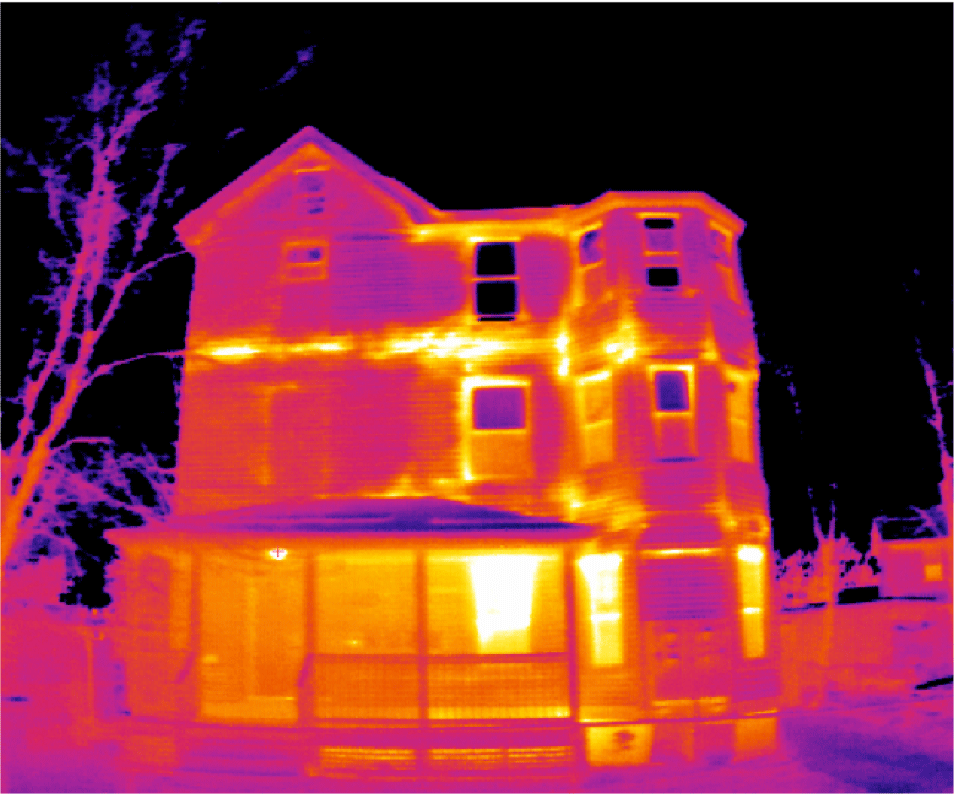
PALMER: And that pays off for homeowners – and for contractors like Leah Daniels.
DANIELS: Once you start to turn the heat on and you get the first bill - everybody’s like Oh my God!
PALMER: Have you done your own house?
DANIELS: (Laughs) Amazing you say that… Yeah my room mate handed me the gas bill one afternoon, and told me he was going to refuse to pay this bill until we insulated the house. So, yes, my own house is done and our gas bill went from about $700 a month to about 2 and a quarter, 250, so he’s happy. (Laughs).
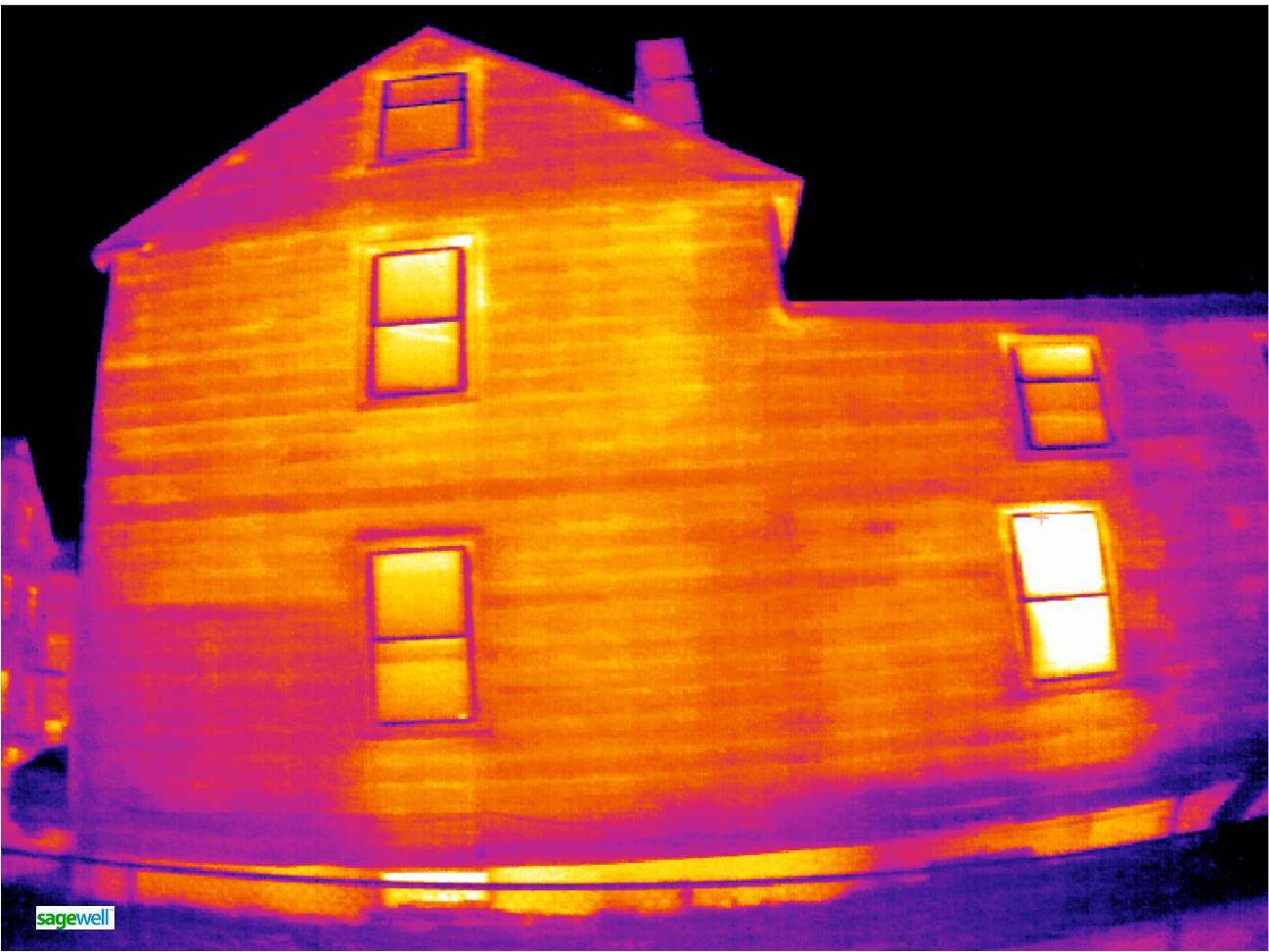
CAPTION (Photo: CREDIT)
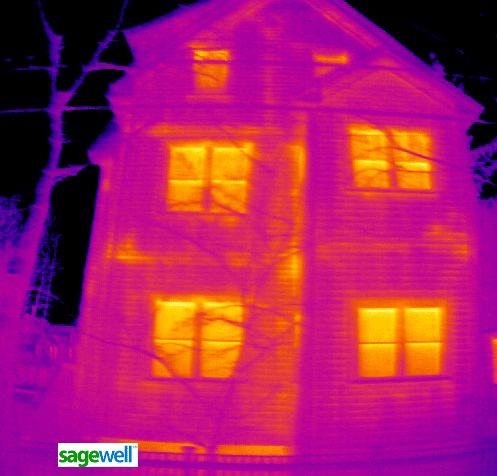
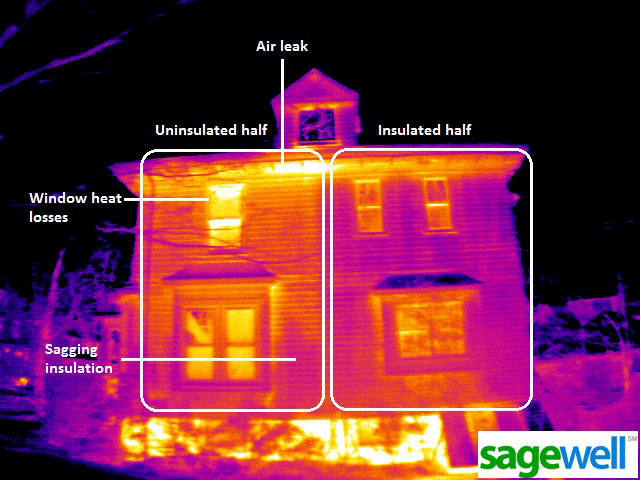
A half-insulated home in Belmont, MA
PALMER: Well, I guess you’re happy too!
DANIELS: (Laughs.) Yeah, we get along better!
PALMER: Which just could be one of the best arguments there is for taking action. For Living on Earth, I'm Helen Palmer.
[MUSIC: Jorma Kaukonen “Midnight in Milpitas” from Quah (BMG Heritage 1973).]
CURWOOD: Check out some of the thermal images – and more -- at our website loe dot org. Coming up – a record criminal fine for BP for the Gulf oil spill is not the end of the story. Keep listening to Living on Earth!
Links
Living on Earth wants to hear from you!
Living on Earth
62 Calef Highway, Suite 212
Lee, NH 03861
Telephone: 617-287-4121
E-mail: comments@loe.org
Newsletter [Click here]
Donate to Living on Earth!
Living on Earth is an independent media program and relies entirely on contributions from listeners and institutions supporting public service. Please donate now to preserve an independent environmental voice.
NewsletterLiving on Earth offers a weekly delivery of the show's rundown to your mailbox. Sign up for our newsletter today!
 Sailors For The Sea: Be the change you want to sea.
Sailors For The Sea: Be the change you want to sea.
 The Grantham Foundation for the Protection of the Environment: Committed to protecting and improving the health of the global environment.
The Grantham Foundation for the Protection of the Environment: Committed to protecting and improving the health of the global environment.
 Contribute to Living on Earth and receive, as our gift to you, an archival print of one of Mark Seth Lender's extraordinary wildlife photographs. Follow the link to see Mark's current collection of photographs.
Contribute to Living on Earth and receive, as our gift to you, an archival print of one of Mark Seth Lender's extraordinary wildlife photographs. Follow the link to see Mark's current collection of photographs.
 Buy a signed copy of Mark Seth Lender's book Smeagull the Seagull & support Living on Earth
Buy a signed copy of Mark Seth Lender's book Smeagull the Seagull & support Living on Earth

